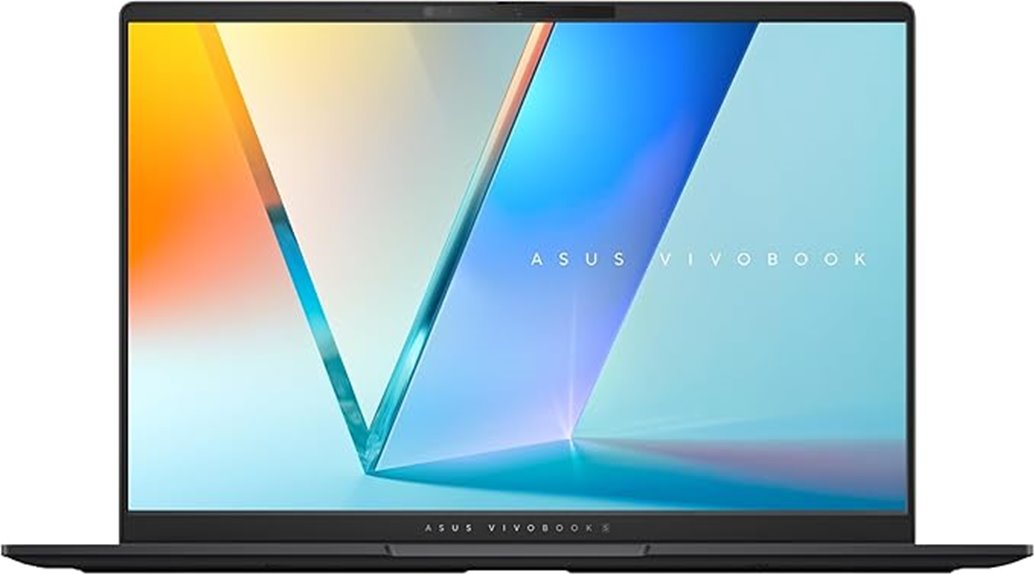Best Laptop for Podcast Editing (Top 5 Picks for 2025)
For podcast editing in 2025, you’ll want to check out the Apple 2024 MacBook Pro with M4 Chip, Acer Swift X 14, Apple MacBook Air 15-inch with M4 Chip, ASUS Vivobook S 14 OLED, and the Samsung Galaxy Book4 Pro. Each of these laptops offers a fantastic blend of power and portability, making your editing tasks smoother and more efficient. Stick around to discover the key features that make each model stand out!
In the interest of full disclosure, we would like to inform you that some links on our website are affiliate links. By clicking on these links and completing a purchase from our partners, we may receive a nominal commission at no extra cost to you. Rest assured, our affiliate partnerships do not compromise the integrity of our editorial content or product evaluations. For further clarification, kindly refer to our comprehensive affiliate disclosure.
Table of Contents
What Are the Best Laptop for Podcast Editing to Buy This Year?
Here are my top picks for the best laptop for podcast editing, you can consider this year.
Apple MacBook Pro Laptop with M4 Chip
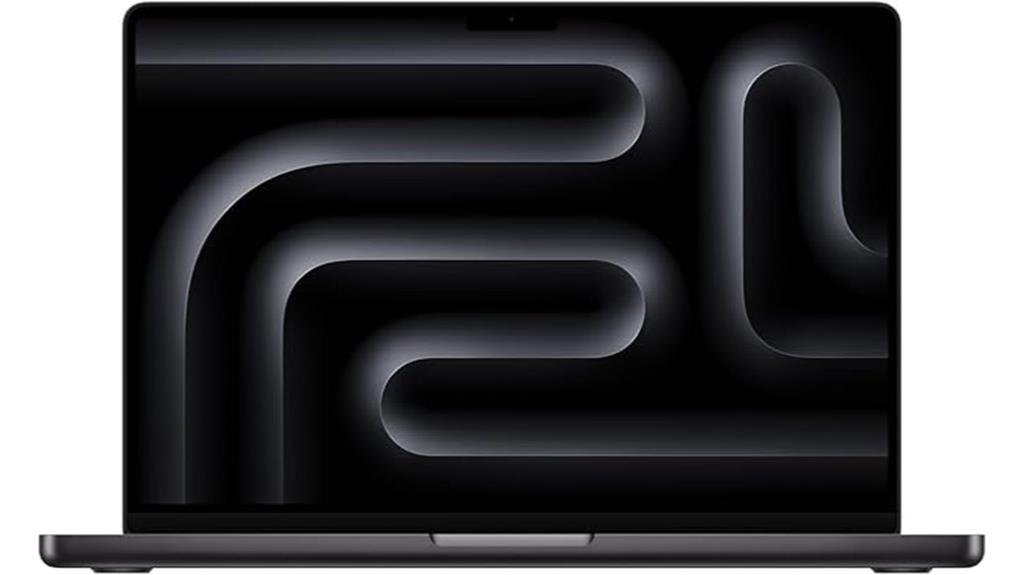
The Apple 2024 MacBook Pro with the M4 chip is an exceptional choice for podcast editors who demand top-tier performance and stunning visuals. With its 10-core CPU and GPU, you’ll experience lightning-fast multitasking that keeps your editing smooth and efficient. The 14.2-inch Liquid Retina XDR display boasts 1600 nits peak brightness and a remarkable contrast ratio of 1,000,000:1, ensuring your visuals are vibrant and true to life. Plus, with 16GB of unified memory and 512GB SSD storage, you can rely on it for your heavy-duty applications like Adobe Creative Cloud while enjoying seamless integration with other Apple devices.
Best For: Podcast editors and creative professionals seeking high-performance computing with stunning visual capabilities.
Pros:
- Exceptional performance with the M4 chip’s 10-core CPU and GPU, ideal for multitasking and running demanding applications.
- Stunning visuals provided by the 14.2-inch Liquid Retina XDR display with high brightness and contrast ratio, enhancing editing precision.
- Seamless integration with the Apple ecosystem, allowing easy access to other devices and applications like Microsoft 365 and Adobe Creative Cloud.
Cons:
- Higher price point compared to other laptops, which may not be suitable for budget-conscious users.
- Limited upgrade options for memory and storage after purchase, potentially restricting future enhancements.
- Weight and size may be less portable compared to ultra-thin laptops, which could be a consideration for on-the-go professionals.
Acer Swift X 14 Laptop (SFX14-72G-77NJ)
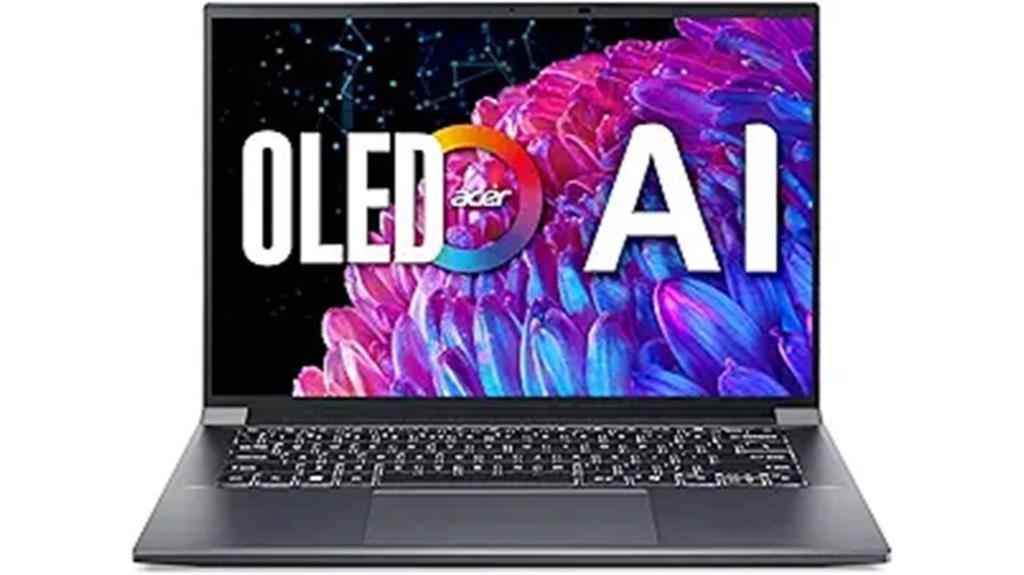
If you’re a podcast editor seeking a powerful and efficient laptop, the Acer Swift X 14 (SFX14-72G-77NJ) stands out with its Intel Core Ultra 7 processor and NVIDIA GeForce RTX 4060 GPU. This laptop’s 14.5-inch OLED display offers stunning visuals at 2880 x 1800 resolution, ensuring vibrant color accuracy. With 16GB RAM and a 1TB SSD, multitasking becomes seamless. You’ll appreciate the 1080p FHD webcam and AI noise reduction for crisp video calls. Plus, the integrated AI tools enhance productivity, making your editing process faster and more efficient. This laptop truly meets the demands of modern podcast editing.
Best For: Podcast editors and creators looking for a powerful, efficient laptop that enhances productivity and visual quality.
Pros:
- Exceptional performance with Intel Core Ultra 7 and NVIDIA GeForce RTX 4060 for demanding tasks.
- Stunning 14.5-inch OLED display with high resolution and color accuracy for clear visuals.
- Integrated AI tools and features that streamline editing and multitasking processes.
Cons:
- The 14.5-inch display may be smaller than what some users prefer for extensive editing work.
- Limited upgrade options for RAM and storage due to soldered components.
- Higher price point compared to other laptops in the market with similar specifications.
Apple MacBook Air 15-inch Laptop with M4 Chip
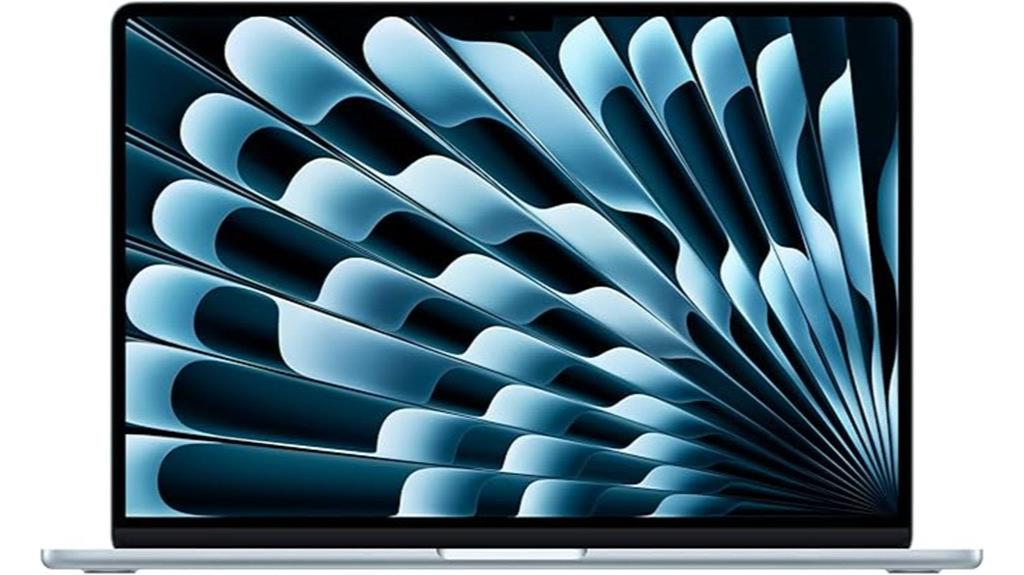
For podcasters seeking a powerful yet portable solution, the Apple MacBook Air 15-inch with M4 chip stands out with its impressive performance and battery life. You’ll enjoy fluid multitasking and video editing, thanks to the M4 chip, which ensures speed even during heavy workloads. The stunning 15.3-inch Liquid Retina display showcases vibrant colors, making your content look sharp. Plus, the 12MP Center Stage camera and six speakers with Spatial Audio deliver exceptional sound and visuals. With ample connectivity options, including two Thunderbolt 4 ports, you can easily set up external displays, enhancing your podcasting experience.
Best For: Podcasters and content creators who need a powerful, portable laptop for multitasking and high-quality audio-visual production.
Pros:
- Impressive Performance: The M4 chip enables smooth multitasking, making it ideal for video editing and other demanding tasks.
- Stunning Display: The 15.3-inch Liquid Retina display offers vibrant colors and sharp detail, enhancing the visual quality of content.
- Excellent Audio and Video Quality: Features like the 12MP Center Stage camera and Spatial Audio provide high-quality sound and visuals for recording and streaming.
Cons:
- Limited Ports: Only two Thunderbolt 4 ports may require additional adapters for some users needing more connectivity options.
- Price Point: Premium pricing may not be accessible for all budget levels.
- Weight: While portable, it may be slightly heavier compared to other ultra-light laptops in the market.
ASUS Vivobook S 14 OLED Slim Laptop (M5406WA-DS76)
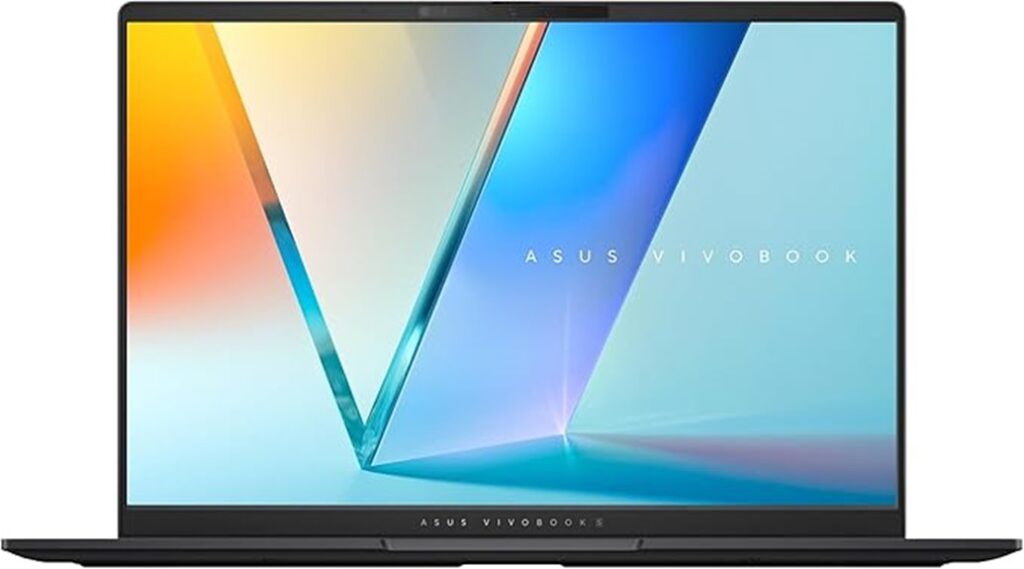
Equipped with a powerful AMD Ryzen 9 365 processor and a stunning 14” 3K OLED display, the ASUS Vivobook S 14 OLED Slim Laptop (M5406WA-DS76) is a top contender for podcast editors seeking both performance and visual excellence. With 24GB LPDDR5X RAM and a 512GB SSD, it ensures smooth multitasking and ample storage for your projects. The 120Hz display offers vibrant colors and quick response times, enhancing your editing experience. Plus, its lightweight design at just 2.87 lbs makes it easy to take anywhere. Connectivity options, including multiple USB ports, ensure you’re equipped for all your editing needs.
Best For: Podcast editors and creative professionals looking for a high-performance laptop with excellent display quality and portability.
Pros:
- Powerful Performance: Equipped with an AMD Ryzen 9 processor and 24GB RAM for seamless multitasking.
- Stunning Display: 14” 3K OLED screen with a 120Hz refresh rate enhances visual editing and viewing experiences.
- Lightweight and Portable: Weighing only 2.87 lbs, it is easy to carry for on-the-go editing.
Cons:
- Limited Storage: 512GB SSD may not be sufficient for large multimedia projects without external storage solutions.
- Price Point: Premium specifications may come with a higher price tag compared to entry-level laptops.
- Non-upgradable RAM: The 24GB LPDDR5X RAM is soldered and cannot be upgraded in the future.
Samsung Galaxy Book4 Pro Business Laptop (NP944XGK-KG4US)
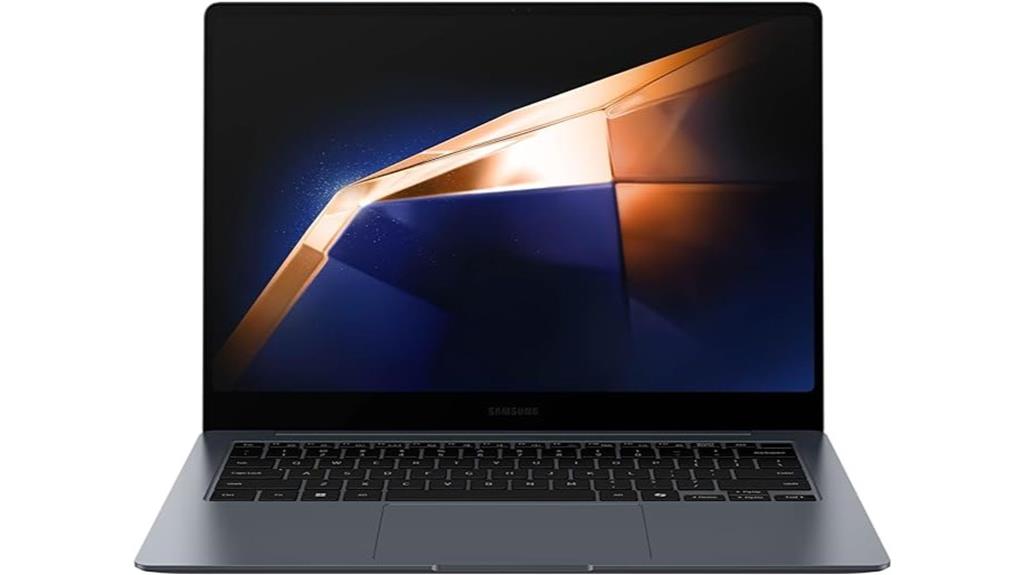
The Samsung Galaxy Book4 Pro Business Laptop (NP944XGK-KG4US) stands out as an excellent choice for podcast editors seeking performance without sacrificing portability. With its powerful Intel Core Ultra 7 processor, 32GB of RAM, and 1TB SSD, you’ll handle multitasking and large audio files effortlessly. The stunning 14-inch 3K AMOLED touchscreen ensures vibrant visuals, while the lightweight design makes it easy to take on the go. Plus, with up to 8 hours of battery life and fast charging, you won’t miss a beat during editing sessions. Its sleek look and solid performance make it a top contender in 2025.
Best For: Professionals and podcast editors seeking a powerful, portable laptop with excellent multitasking capabilities and a vibrant display.
Pros:
- Exceptional performance with Intel Core Ultra 7 processor and 32GB RAM for handling large audio files and multitasking seamlessly.
- Stunning 14-inch 3K AMOLED touchscreen provides vibrant visuals and an immersive editing experience.
- Lightweight and slim design makes it highly portable, ideal for on-the-go professionals.
Cons:
- Higher retail price ($1749) compared to competitors with similar or better specifications.
- Limited RAM upgrade options in certain regions, capped at 16GB.
- Perceived lower quality of the OEM SSD from Western Digital for the price point.
READ MORE: Best Laptop for Influencers, Best Laptop for Excel Spreadsheets, Best Laptop for Dropshipping Busines, Best Laptop for Data Science Students, Best Laptop for Data Engineer, Best Laptop for Blogging and Podcasting, Best Laptop for Dental School, Best Laptop for Grandma, Best Laptop for Full Stack Developer, Best Laptop for Fruity Loops
Factors to Consider When Choosing the Best Laptop for Podcast Editing
When choosing a laptop for podcast editing, you need to consider several key factors. Think about the processing power, display quality, and battery life, as these will directly impact your editing experience. Additionally, don’t overlook audio and webcam features, along with portability, since you might be on the go.
Processing Power Requirements
Choosing the right laptop for podcast editing hinges on processing power, as it directly impacts your editing experience. You’ll want a robust processor, ideally with at least 8 cores, to manage multiple audio tracks and effects smoothly. Aim for a minimum of 16GB of RAM to handle larger audio files and multitasking without hiccups. While integrated graphics can suffice for basic tasks, a dedicated GPU will boost rendering times and performance during complex edits. Fast SSD storage of at least 512GB is crucial for quick access to your files, preventing slowdowns. Lastly, consider battery life; podcast editing can be resource-intensive, so you’ll need a laptop that can last through long editing sessions without frequent recharges.
Display Quality Importance
While editing podcasts, having a high-quality display can significantly enhance your workflow and precision. A high-resolution screen, like 3K or 4K, offers clarity that makes it easier to edit audio waveforms and visual elements accurately. Displays with peak brightness levels of 600 nits or more ensure visibility in bright environments, crucial for effective work. An aspect ratio of 16:10 provides extra vertical space, allowing you to view timelines and multiple tracks side by side without excessive scrolling. Additionally, color accuracy, such as 100% DCI-P3, ensures your visuals align with the intended look, especially when incorporating graphics. Finally, fast response times, like 0.2 ms, minimize motion blur, making your editing experience smoother and more responsive.
Battery Life Considerations
As you dive into podcast editing, battery life becomes a crucial factor that can make or break your productivity. Aim for a laptop with at least 8 hours of battery life to ensure uninterrupted workflow during long editing sessions. Laptops boasting all-day battery capabilities allow you the freedom to work anywhere, whether plugged in or not. Fast charging is another feature worth considering, as it minimizes downtime and quickly gets you back to work. Keep in mind that demanding software can drain battery life, so choose models optimized for efficiency in multimedia tasks. Lastly, ensure your laptop supports multitasking features, as running multiple applications simultaneously can heavily tax your battery. Choosing wisely will enhance your editing experience.
Audio and Webcam Features
When it comes to podcast editing, having the right audio and webcam features can significantly enhance your workflow and output quality. Choose a laptop with a high-quality webcam, like a 1080p FHD model, to ensure clear visuals during video recordings and live sessions. Look for advanced audio capabilities, including multiple microphones and noise reduction technology, which will improve sound quality and minimize background noise. A laptop with integrated spatial audio and high-quality speakers can elevate your audio experience during playback and editing. It’s also crucial to have robust processing power to handle audio editing software seamlessly. Finally, opt for good connectivity options, such as USB ports and audio jacks, to easily connect external microphones and headphones for professional audio capture.
Portability and Weight
Portability and weight are vital considerations for podcast editors who often find themselves working on-the-go. You’ll want a lightweight laptop, ideally under 3 lbs, to make travel easier. A slim profile around 0.6 inches thick lets your device slip into bags without hassle. Battery life is another key factor; laptops that last up to 18 hours on a single charge minimize the need for frequent plug-ins during your travels. Furthermore, a display size of 14 to 15 inches strikes the perfect balance, providing enough workspace while maintaining portability. Lightweight materials and compact designs enhance your experience, allowing you to carry your laptop comfortably during long editing sessions or while moving between locations.
Connectivity Options Available
Finding a laptop that meets your podcast editing needs goes beyond just portability. You’ll want multiple USB ports, including both USB-C and USB-A, to connect essential devices like audio interfaces, microphones, and external drives. Thunderbolt 4 ports are also a great choice, offering high data transfer speeds and support for multiple high-resolution displays, which can enhance your editing workflow. A headphone jack is crucial for direct audio monitoring, ensuring accurate sound editing. Additionally, look for a microSD card reader to simplify transferring audio files from portable recording devices. Finally, opt for laptops that support advanced wireless connectivity options like Wi-Fi 6E and Bluetooth 5.3, making collaboration and file sharing during remote editing sessions seamless.
Operating System Compatibility
Choosing the right operating system for your podcast editing laptop is crucial, as it directly impacts your editing experience and software compatibility. If you prefer macOS, you’ll enjoy seamless integration with other Apple devices, allowing features like iPhone mirroring and AirDrop for easy file sharing. However, if you lean towards Windows, you’ll find a broader range of audio editing software options, including Adobe Audition and Pro Tools, which are essential for many podcasters. Don’t forget about audio drivers and plugins—ensure your chosen OS supports them for high-quality audio processing. Additionally, consider battery performance; different operating systems can affect how long you can edit on-the-go without needing to plug in, especially when using resource-intensive applications.
Frequently Asked Questions
What Software Is Best for Podcast Editing on These Laptops?
When editing podcasts, you’ll want to consider software like Audacity, Adobe Audition, or GarageBand. Each offers unique features, so you can choose one that fits your editing style and workflow preferences best.
Are These Laptops Suitable for Video Editing as Well?
Yes, these laptops are suitable for video editing too. They offer powerful processors and ample RAM, making multitasking a breeze. You’ll find their performance meets your needs for both podcast and video editing seamlessly.
How Much RAM Is Ideal for Podcast Editing?
For podcast editing, you’ll want at least 16GB of RAM to ensure smooth performance. If you’re working with multiple tracks or software, consider upgrading to 32GB for even better efficiency and processing power.
Can I Upgrade the Storage on These Laptops?
Yes, you can upgrade the storage on many laptops. Check your model’s specifications and ensure it supports additional drives. With a little research, you’ll enhance your device’s capacity for storing podcasts efficiently.
What Is the Average Battery Life for Podcast Editing Tasks?
When editing podcasts, you can expect an average battery life of around 6 to 10 hours. It largely depends on your laptop’s specifications and the intensity of your editing tasks. Always carry a charger just in case!
My Final Opinion
In 2025, you’ve got some fantastic options for podcast editing laptops that blend power and portability. Whether you lean towards the Apple M4 chip for its performance or the sleek design of the Acer Swift X, each choice has its strengths. Remember to consider factors like processing power, battery life, and screen quality to find the perfect fit for your editing needs. With the right laptop, you’re all set to create engaging podcasts that stand out!
